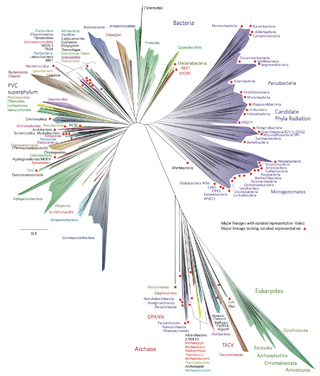
Acidobacteriota is a phylum of Gram-negative bacteria. Its members are physiologically diverse and ubiquitous, especially in soils, but are under-represented in culture.

The Chlamydiota are a bacterial phylum and class whose members are remarkably diverse, including pathogens of humans and animals, symbionts of ubiquitous protozoa, and marine sediment forms not yet well understood. All of the Chlamydiota that humans have known about for many decades are obligate intracellular bacteria; in 2020 many additional Chlamydiota were discovered in ocean-floor environments, and it is not yet known whether they all have hosts. Historically it was believed that all Chlamydiota had a peptidoglycan-free cell wall, but studies in the 2010s demonstrated a detectable presence of peptidoglycan, as well as other important proteins.

Listeria is a genus of bacteria that acts as an intracellular parasite in mammals. By 2024, 28 species had been identified. The genus is named in honour of the British pioneer of sterile surgery Joseph Lister. Listeria species are Gram-positive, rod-shaped, and facultatively anaerobic, and do not produce endospores.
Heliobacteria are a unique subset of prokaryotic bacteria that process light for energy. Distinguishable from other phototrophic bacteria, they utilize a unique photosynthetic pigment, bacteriochlorophyll g and are the only known Gram-positive phototroph. They are a key player in symbiotic nitrogen fixation alongside plants, and use a type I reaction center like green-sulfur bacteria.

Stilbenoids are hydroxylated derivatives of stilbene. They have a C6–C2–C6 structure. In biochemical terms, they belong to the family of phenylpropanoids and share most of their biosynthesis pathway with chalcones. Most stilbenoids are produced by plants, and the only known exception is the antimicrobial stilbenoid drug tapinarof which is biosynthesized by the Gram-negative bacterium Photorhabdus luminescens.

Photorhabdus luminescens is a Gammaproteobacterium of the family Morganellaceae, and is a lethal pathogen of insects.

Bacterial phyla constitute the major lineages of the domain Bacteria. While the exact definition of a bacterial phylum is debated, a popular definition is that a bacterial phylum is a monophyletic lineage of bacteria whose 16S rRNA genes share a pairwise sequence identity of ~75% or less with those of the members of other bacterial phyla.
Alistipes is a Gram-negative genus of rod-shaped anaerobic bacteria in the phylum Bacteroidota. When members of this genus colonize the human gastrointestinal (GI) tract, they provide protective effects against colitis, autism, and cirrhosis. However, this genus can also cause dysbiosis by contributing to anxiety, chronic fatigue syndrome, depression, and hypertension. Showcasing priority effects in microbiome assembly, when infant GI tracts have bacteria of the species Staphylococcus but not the species Faecalibacterium, Alistipes species become less capable of colonization. Alistipes, typically benign in the gut, can sometimes trigger infections like intra-abdominal abscesses and bloodstream infections, emphasizing the fine line between symbiosis and disease. This underscores the significance of comprehending their impact on human health within microbial ecosystems.
Xenorhabdus is a genus of motile, gram-negative bacteria from the family of the Morganellaceae. All the species of the genus are only known to live in symbiosis with soil entomopathogenic nematodes from the genus Steinernema.
Pseudomonas protegens are widespread Gram-negative, plant-protecting bacteria. Some of the strains of this novel bacterial species previously belonged to P. fluorescens. They were reclassified since they seem to cluster separately from other fluorescent Pseudomonas species. P. protegens is phylogenetically related to the Pseudomonas species complexes P. fluorescens, P. chlororaphis, and P. syringae. The bacterial species characteristically produces the antimicrobial compounds pyoluteorin and 2,4-diacetylphloroglucinol (DAPG) which are active against various plant pathogens.
Photorhabdus is a genus of bioluminescent, gram-negative bacilli which lives symbiotically within entomopathogenic nematodes, hence the name photo and rhabdus. Photorhabdus is known to be pathogenic to a wide range of insects and has been used as biopesticide in agriculture.
Arsenophonus nasoniae is a species of bacterium which was previously isolated from Nasonia vitripennis, a species of parasitoid wasp. These wasps are generalists which afflict the larvae of parasitic carrion flies such as blowflies, houseflies and flesh flies. A. nasoniae belongs to the phylum Pseudomonadota and family Morganellaceae. The genus Arsenophonus, has a close relationship to the Proteus (bacterium) rather than to that of Salmonella and Escherichia. The genus is composed of gammaproteobacterial, secondary-endosymbionts which are gram-negative. Cells are non-flagellated, non-motile, non-spore forming and form long to highly filamentous rods. Cellular division is exhibited through septation. The name 'Arsenophonus nasoniae gen. nov., sp. nov.' was therefore proposed for the discovered bacterium due to its characteristics and its microbial interaction with N. vitripennis. The type strain of A. nasoniae is Strain SKI4.
Streptococcus infantarius is a species of bacteria.

Heterorhabditis megidis is a species of nematodes in the genus Heterorhabditis. All species of this genus are obligate parasites of insects, and some are used as biological control agents for the control of pest insects.
Ji Hee Kim is a Korean Antarctic researcher, best known for being the Principal Investigator for comprehensive environmental monitoring and construction of the long term environmental database at South Korea's King Sejong Station.
Xenorhabdus vietnamensis is a bacterium from the genus Xenorhabdus which has been isolated from the nematode Steinernema sangi in Vietnam.
Azospirillum is a Gram-negative, microaerophilic, non-fermentative and nitrogen-fixing bacterial genus from the family of Rhodospirillaceae. Azospirillum bacteria can promote plant growth.
Pontibacter is a strictly aerobic bacterial genus from the family Hymenobacteraceae.

The Morganellaceae are a family of Gram-negative bacteria that include some important human pathogens formerly classified as Enterobacteriaceae. This family is a member of the order Enterobacterales in the class Gammaproteobacteria of the phylum Pseudomonadota. Genera in this family include the type genus Morganella, along with Arsenophonus, Cosenzaea, Moellerella, Photorhabdus, Proteus, Providencia and Xenorhabdus.
Ann Patricia Wood is a retired British biochemist and bacteriologist who specialized in the ecology, taxonomy and physiology of sulfur-oxidizing chemolithoautotrophic bacteria and how methylotrophic bacteria play a role in the degradation of odour causing compounds in the human mouth, vagina and skin. The bacterial genus Annwoodia was named to honor her contributions to microbial research in 2017.







